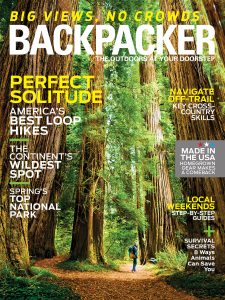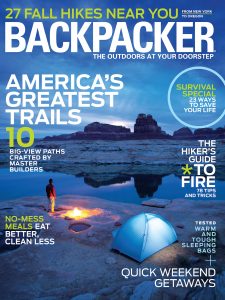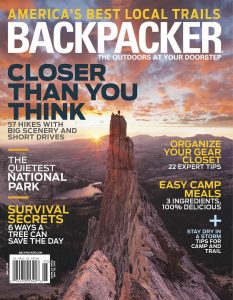


This magazine has changed substantially since our last entry, so we’ve written a full update!
This Colorado-based consumer magazine focuses on backpacking, hiking, and camping tips and destinations.
Type of magazine: Consumer
Publication frequency: Nine issues per year
Percentage of travel content: 70%
Language(s): English
Publisher: Cruz Bay Publishing, Inc., an Active Interest Media company
Location of editorial: Boulder, Colorado
Website: www.backpacker.com
Editorial positioning: “Backpacker magazine inspires and empowers our readers to Get Out More—to enjoy the world outside more often. As the authority on escaping to the backcountry, Backpacker offers readers accessible, close-to-home getaways alongside exotic life-list destinations, practical tips for outdoor adventure and the best gear information available.”
Read online: Paid only at www.magzter.com/US/Active_Interest_Media/Backpacker/Travel/
Circulation: 331,038
Total readership: 1.24 million
Target audience: Readers are primarily knowledgeable and experienced backpackers, and looking to improve their backcountry experience and discover new destinations, gear, and techniques. They are 67% male with a median age of 41 years and have a median household income of $88,267.
Editorial structure
Front of book sections: “#trailchat,” “Play List,” which contains “Viewfinder,” “Insider’s Guide,” “Life List,” “The Experience,” “Weekends,” “Done in a Day,” and “Geopinion.” “Skill Set,” which contains “Adventure,” “Pass/Fail,” “Trail Chef,” “Boot Camp,” and “Out Alive.” “Field Test,” which contains “Trail Mix,” “Shakedown,” “The Kit,” and “Round-Up”.
Features: There are about four to seven features per issue. These are not found in pre-established categories.
Back of book sections: “Uncovered”
What to pitch: There are about 11 freelance writers per issue. “Insider’s Guide,” “Life List,” “The Experience,” “Weekends,” “Done in a Day,” “Geopinion,” “Adventure U,” “Pass/Fail,” “Trail Chef,” “Boot Camp,” “Out Alive,” and the features are written by freelancers.
Sections written by a member of editorial staff are “Viewfinder,” “In the Club,” the uncategorized articles in “Field Test,” “Trail Mix,” and “Uncovered.” Along with freelancers, they also contribute to “Insider’s Guide,” “Life List,” “The Experience,” “Done in a Day,” “Out Alive,” the uncategorized articles in “Field Test,” and the features. “#trailchat” is made up of reader-contributed comments and photos.
“Insider’s Guide” gives the reader information on a different outdoors location each issue with tips and advice from an expert, such as a park ranger. In 300 to 500 words, the piece covers some information about the expert and how to visit under the subheadings of “The Insider” and “Trip Planner” respectively. Beyond these, six changing sections can be found covering further advice on visiting the destination such as an easy day hike, a longer route, how to camp overnight, what to do after the hike, and when to visit. The article is written in third person and include quotes from the expert. Destinations covered recently include Eastern Sierra Navada in California, the Cordova Ranger District Chugach National Forrest in Alaska, and Columbia River Gorge in Oregon and Washington.
“Life List” is first-person narrative article in which the writer shares an experience they had in an outdoor location, often hiking or with wildlife. In 300 to 400 words, the piece covers what the writer saw and did while in the destination. There’s a sidebar called “Do It” at the end of each article which covers how readers can replicate the trip with details such as transport, tour guides, and when to visit. Examples of articles from this section include “Take a Change on an Unnamed Lake,” which covers the writer’s experience hiking in Peru’s Cordillera Blanca to find an unnamed lake, “Island Time,” covering the writer’s trip to Jamaica to visit the Blue Mountains, and “Safari on Foot,” where the writer recounts his safari experience in northern Kenya with his son.
“The Experience” also takes the form of first-person article where, in about 300 words, the writer recounts a story with an outdoor and environment theme, such as hiking or camping. They describe what they saw and how they felt. This is sometimes followed by a “Do It” sidebar giving the reader information to help them replicate the trip like useful websites. Recent examples include “Hit the Pavement Road Walking,” where the writer recounts her trip walking across Carolina and her thoughts on road walking versus trails, “Easy Does It Car Camping,” about camping alone in the Eastern Sierra, and “Light Up the Night: Seeing Bioluminescence,” where the writer describes seeing bioluminescence while camping on the coast of Isla Carmen, Baja.
There are usually two “Weekends” articles per issue which cover different hiking destinations, most often in the U.S. There’s a 100-word introduction to the area with a brief mention of the writer’s first-person experience visiting. This is followed by a breakdown of useful information for visiting and replicating the trip. The subtitles of “Turn-by-Turn,” which outlines a step-by-step route, and “Campsite,” describing where to camp, can be found. Beyond these, there are usually three or four further sections which could cover information on the wildlife, geology or how to add an extra day to the trip, for example. Articles are about 300 words in total, including the introduction, and outline the distance, time it takes, and give a difficulty rating at the end of the piece. Examples include “Highs & Low,” which covers Harrison Hills, Wisconsin, “On Edge,” about Catskill Park, New York and “Aim High,” on John Muir Wilderness, California.
“Done in a Day” rounds up three to four hikes or outdoor adventures in locations close to major U.S. cities. The article is about 500 words long and is written in third person. Recent examples include “Mushroom Hikes,” which rounds up four routes where you can forage for mushrooms, “Urban Adventures,” rounding up three trails close to U.S. cities, and “Ripe for the Pickin’” covering four routes where you can pick berries.
“Geopinion” is an essay about hiking or the outdoors which runs to about 400 words. It’s written in first person and the writer shares their opinion on something, sometimes by sharing anecdotes from their own experience. The tone is conversational, informal, and often humorous. Examples include “Head First,” where the writer describes a fall he has while hiking and why hikers shouldn’t be embarrassed of falling, “See You in Hells,” on why the writer thinks Hells Canyon is better than the Grand Canyon, and “Bigfoot Marketing Plan,” a humorous piece on why Bigfoot should come of hiding and rebrand his image.
“Adventure U” rounds up tips and advice on a hiking or outdoor topic. Articles run to about 300 words with six pieces of advice. It’s written in a second-person style with quotes form an expert throughout, such as an athlete or doctor. There’s a sidebar called “Cheat Sheet” which rounds up further tips on the topic. Examples include “Hike in a Heat Wave,” with advice for handling hot weather, “Get Behind the Lens,” covering photography tips, and “Hike Huge Miles,” on hiking long distances with tips from a record holder for the Appalachain Trail.
“Pass/Fail” is a first-person narrative article where the writer shares their experience trying something new related to hiking or the outdoors. This could be an activity or style of hiking, for example. Articles are about 500 words long and written in a humorous and conversational style. At the end of the piece the writer shares if this new thing they tried was a ‘pass’ or ‘fail’ and the reasons why. There’s a sidebar called “Key Skills” which rounds up tips for how to do the main subject covered in the article. Recent examples include “Navigate the Jungle,” about the writer’s failed attempt at leading a hike in Columbia, “Have Fun in a Canoe,” covering how the writer learned to love canoeing, and “Ditch the Pants,” where the writer describes her experience with hiking dresses.
“Trail Chef” rounds up three recipes around a theme. The article is about 300 words long and lists the ingredients followed by a step-by-step method. Recent round ups include three dishes which are high in protein, three budget-friendly meals, and three meals you can make on the campfire.
“Boot Camp” rounds up exercises to help with hiking and outdoor activities. Articles run to about 400 words and are written in second person with advice from an expert. The sidebar “You’re Doing It Wrong” accompanies each article and gives readers tips on common mistakes which are often made with the exercises. Examples for this section include “Power Up,” with exercises to improve your lactate threshold, “Hurt-Proof,” with methods for strengthening joints, and “Hard Core,” about how to increase core strength.
“Out Alive” is a first-person as-told-to style article which covers a story of something going wrong while hiking. Often this includes getting lost or injured while alone in a remote and rural area. The article runs to about 600 words and tells the story of what happened and how the hiker survived. The sidebar “Key Skills” can be found here which rounds up three tips for getting out of the same situation. Recent examples for this section include “Lost in the Rainforest,” “Trapped with a Broken Leg,” and “Lost and Injured,” all of which tell the hiker’s story of getting lost and injured alone but eventually rescued.
There are about four features per issue with freelancers usually contributing to two of them. These cover hikes and outdoor adventures, usually in the U.S., in 2,000 to 3,500 words. Features can be written as a first-person narrative story, a third-person round up, or a profile. Profiles include quotes throughout from the person being covered. Recent features include “The Last Canyon,” covering the writer’s experience exploring canyons in Utah, “Rivers Wild,” a round up of 11 trips through the National Wild and Scenic Rivers, and “Walking on to the Horizon,” profiling Steve Myers and the creation of the Great Plains Trail.
There’s a lead time of at least six months.
Are there additional opportunities online? Yes, the general categories of content for online articles are best lists, videos, slideshows, and ask an expert.
Pay rates: $0.40 to more than $1.00 per word based on the complexity and demands of the article and the past experience of the writer.
Phone: 1(800)666-3434
Email format: Primarily firstinitiallastname@aimmedia.com. The editor-in-chief uses firstinitiallastname@backpacker.com and the deputy editor uses firstnamelastname@aimmedia.com.
Size of editorial staff: Large
Editors:
- Editorial Director: Shannon Davis
- Executive Editor: Casey Lyons
- Senior Digital Editor: Adam Roy
- Gear Editor: Eli Bernstein
- Northwest Field Editor: Ted Alvarez
- Rocky Mountain Field Editor: Elisabeth Kwak-Hefferan
- Southwest Field Editor: Annette McGivney
Last update: 12/20/20